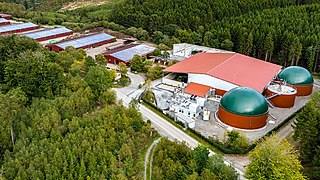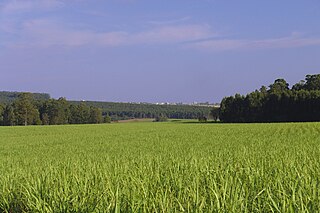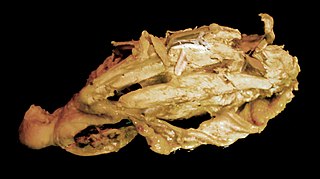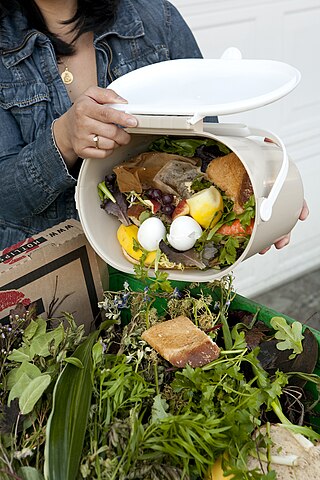
Digeponics (pronounced die-jeh-ponics, as in digestion) is a method of agriculture which integrates the products of anaerobic digestion, including CO2 and digestate, with greenhouse cultivation of vegetables. [1]

Digeponics (pronounced die-jeh-ponics, as in digestion) is a method of agriculture which integrates the products of anaerobic digestion, including CO2 and digestate, with greenhouse cultivation of vegetables. [1]
Digeponics was developed in Norway by the "Food to Waste to Food" (F2W2F) program, a part of the EU Eco-innovation Initiative, in partnership with the waste management company Lindum AS. [1] [2] [3]
The method involves the use of various products of anaerobic digestion in the cultivation of vegetables in a greenhouse environment. The more widely used aspects include the use of biogas for electricity production, which is used for lighting and heating the greenhouse in the winter months, as well as the introduction of carbon dioxide into the greenhouse, which is a byproduct of biogas combustion, for increased plant growth. The more novel aspect of this method is the use of a "mix of vermicompost and garden waste compost fertilized by (non-separated) digestate in a circulating system including earth worms in the substrate and aeration in a biofilter buffer tank." [1]
Research conducted on digeponics found that this method, and others like it, could meet or exceed the production rates of mineral fertilizers. For tomato production, digeponics yielded 5430 g, compared to 4920 g for mineral fertilizers. For cucumber production, digeponics yielded 19560g, compared to 8502g for mineral fertilizers. [1]
In addition to increased yields, this method can provide decreased energy costs and very low carbon emissions, by producing energy on site from renewable carbon neutral sources that are readily available to the farmer, and could even provide an additional source of income by charging tipping fees for organic waste collection and selling excess electricity or gas back into the grid. Methane emissions were shown to be reduced by 98%, compared to landfilling of organic waste, and carbon emissions were reduced 95%, compared with conventional tomato greenhouse production. [1]

Compost is a mixture of ingredients used as plant fertilizer and to improve soil's physical, chemical, and biological properties. It is commonly prepared by decomposing plant and food waste, recycling organic materials, and manure. The resulting mixture is rich in plant nutrients and beneficial organisms, such as bacteria, protozoa, nematodes, and fungi. Compost improves soil fertility in gardens, landscaping, horticulture, urban agriculture, and organic farming, reducing dependency on commercial chemical fertilizers. The benefits of compost include providing nutrients to crops as fertilizer, acting as a soil conditioner, increasing the humus or humic acid contents of the soil, and introducing beneficial microbes that help to suppress pathogens in the soil and reduce soil-borne diseases.

Biogas is a gaseous renewable energy source produced from raw materials such as agricultural waste, manure, municipal waste, plant material, sewage, green waste, wastewater, and food waste. Biogas is produced by anaerobic digestion with anaerobic organisms or methanogens inside an anaerobic digester, biodigester or a bioreactor. The gas composition is primarily methane and carbon dioxide and may have small amounts of hydrogen sulfide, moisture and siloxanes. The gases methane and hydrogen can be combusted or oxidized with oxygen. This energy release allows biogas to be used as a fuel; it can be used in fuel cells and for heating purpose, such as in cooking. It can also be used in a gas engine to convert the energy in the gas into electricity and heat.

Biofuel is a fuel that is produced over a short period from biomass, rather than by the very slow natural processes involved in the formation of fossil fuels, such as oil. Biofuel can be produced from plants or agricultural, domestic, or industrial biowaste. Biofuels are mostly used for transportation but can also be used for heating and electricity. Biofuels are regarded as a renewable energy source. However, the use of biofuel has been controversial because of the several disadvantages associated with the use of it. These include for example : the "food vs fuel" debate, biofuel production methods being sustainable or not, leading to deforestation and loss of biodiversity or not.
Alternative technology is a term used to refer to technologies that are more environmentally friendly than the functionally equivalent technologies dominant in current practice. The term was coined by Peter Harper, one of the founders of the Centre for Alternative Technology, North Wales, in Undercurrents (magazine) in the 1970s. Alternative Technologies are created to be safer, cleaner, and overall more efficient. The goals of alternative technology are to decrease demand for critical elements by ensuring a secure supply of technology that is environmentally friendly, increased efficiency with lower costs, and with more common materials to avoid potential future materials crises. Alternative technologies use renewable energy sources such as solar power and wind energy. Some alternative technologies have in the past or may in the future become widely adopted, after which they might no longer be considered "alternative." For example, the use of wind turbines to produce electricity.

Anaerobic digestion is a sequence of processes by which microorganisms break down biodegradable material in the absence of oxygen. The process is used for industrial or domestic purposes to manage waste or to produce fuels. Much of the fermentation used industrially to produce food and drink products, as well as home fermentation, uses anaerobic digestion.

Bioenergy is energy made or generated from biomass, which consists of recently living organisms, mainly plants. Types of biomass commonly used for bioenergy include wood, food crops such as corn, energy crops and waste from forests, yards, or farms. The IPCC defines bioenergy as a renewable form of energy. Bioenergy can either mitigate or increase greenhouse gas emissions. There is also agreement that local environmental impacts can be problematic.
Articles related to waste management include:

A garbage disposal unit (also known as a waste disposal unit, food waste disposer (FWD), in-sink macerator, garbage disposer, or garburator) is a device, usually electrically powered, installed under a kitchen sink between the sink's drain and the trap. The device shreds food waste into pieces small enough—generally less than 2 mm (0.079 in) in diameter—to pass through plumbing.

Sewage sludge treatment describes the processes used to manage and dispose of sewage sludge produced during sewage treatment. Sludge treatment is focused on reducing sludge weight and volume to reduce transportation and disposal costs, and on reducing potential health risks of disposal options. Water removal is the primary means of weight and volume reduction, while pathogen destruction is frequently accomplished through heating during thermophilic digestion, composting, or incineration. The choice of a sludge treatment method depends on the volume of sludge generated, and comparison of treatment costs required for available disposal options. Air-drying and composting may be attractive to rural communities, while limited land availability may make aerobic digestion and mechanical dewatering preferable for cities, and economies of scale may encourage energy recovery alternatives in metropolitan areas.

The European Union's Animal By-Products Regulations allows for the treatment of some animal by-products in composting and biogas plants. The following article describes procedures required to allow solid outputs from composting plants and anaerobic digesters onto land in the United Kingdom.

Biodegradable waste includes any organic matter in waste which can be broken down into carbon dioxide, water, methane, compost, humus, and simple organic molecules by micro-organisms and other living things by composting, aerobic digestion, anaerobic digestion or similar processes. It mainly includes kitchen waste, ash, soil, dung and other plant matter. In waste management, it also includes some inorganic materials which can be decomposed by bacteria. Such materials include gypsum and its products such as plasterboard and other simple sulfates which can be decomposed by sulfate reducing bacteria to yield hydrogen sulfide in anaerobic land-fill conditions.

Digestate is the material remaining after the anaerobic digestion of a biodegradable feedstock. Anaerobic digestion produces two main products: digestate and biogas. Digestate is produced both by acidogenesis and methanogenesis and each has different characteristics. These characteristics stem from the original feedstock source as well as the processes themselves.

Algae fuel, algal biofuel, or algal oil is an alternative to liquid fossil fuels that uses algae as its source of energy-rich oils. Also, algae fuels are an alternative to commonly known biofuel sources, such as corn and sugarcane. When made from seaweed (macroalgae) it can be known as seaweed fuel or seaweed oil.

Agricultural pollution refers to biotic and abiotic byproducts of farming practices that result in contamination or degradation of the environment and surrounding ecosystems, and/or cause injury to humans and their economic interests. The pollution may come from a variety of sources, ranging from point source water pollution to more diffuse, landscape-level causes, also known as non-point source pollution and air pollution. Once in the environment these pollutants can have both direct effects in surrounding ecosystems, i.e. killing local wildlife or contaminating drinking water, and downstream effects such as dead zones caused by agricultural runoff is concentrated in large water bodies.

Manure is organic matter that is used as organic fertilizer in agriculture. Most manure consists of animal feces; other sources include compost and green manure. Manures contribute to the fertility of soil by adding organic matter and nutrients, such as nitrogen, that are utilised by bacteria, fungi and other organisms in the soil. Higher organisms then feed on the fungi and bacteria in a chain of life that comprises the soil food web.

Source-separated organics (SSO) is the system by which waste generators segregate compostable materials from other waste streams at the source for separate collection.

Harvest Power, Inc. was a privately held organics management company headquartered in Waltham, Massachusetts, United States that specializes in converting food waste and yard waste into biofuel, compost, mulch and fertilizer. In 2014 Fast Company named it one of the most innovative companies in the world. In August of 2020 Harvest Power Orlando ceased operations for unknown reasons and all assets were put up for sale; the company was dissolved in April 2021.

Climate-friendly gardening is a form of gardening that can reduce emissions of greenhouse gases from gardens and encourage the absorption of carbon dioxide by soils and plants in order to aid the reduction of global warming. To be a climate-friendly gardener means considering both what happens in a garden and the materials brought into it and the impact they have on land use and climate. It can also include garden features or activities in the garden that help to reduce greenhouse gas emissions elsewhere.

Reuse of human excreta is the safe, beneficial use of treated human excreta after applying suitable treatment steps and risk management approaches that are customized for the intended reuse application. Beneficial uses of the treated excreta may focus on using the plant-available nutrients that are contained in the treated excreta. They may also make use of the organic matter and energy contained in the excreta. To a lesser extent, reuse of the excreta's water content might also take place, although this is better known as water reclamation from municipal wastewater. The intended reuse applications for the nutrient content may include: soil conditioner or fertilizer in agriculture or horticultural activities. Other reuse applications, which focus more on the organic matter content of the excreta, include use as a fuel source or as an energy source in the form of biogas.
Home composting is the process of using household waste to make compost at home. Composting is the biological decomposition of organic waste by recycling food and other organic materials into compost. Home composting can be practiced within households for various environmental advantages, such as increasing soil fertility, reduce landfill and methane contribution, and limit food waste.